The Web3 Wave Has Arrived: From Intent Trading to DeFAI
On January 16, 2025, the highly anticipated Solana AI Hackathon officially announced its results. This 15-day AI hackathon gathered enthusiastic participation from over 400 projects, and after fierce competition, the DeFAI project The Hive (BUZZ) emerged as the champion, winning a prize of $60,000.
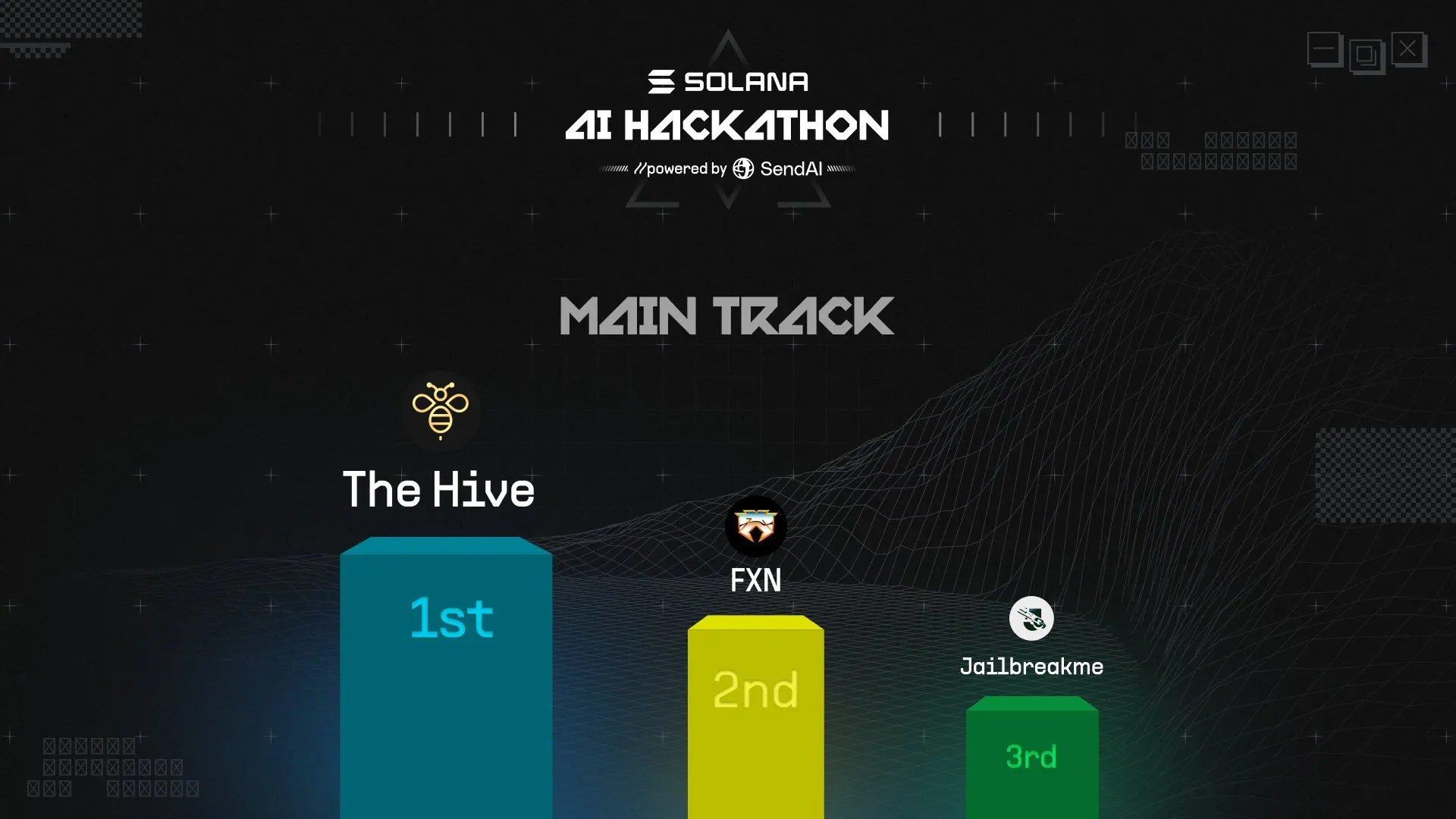
The Hive is a modular and interoperable DeFi Agent network built on Solana. Using a Swarm architecture, The Hive can automatically handle complex DeFi operations such as trading, staking, and lending through users' chat commands. The Hive was developed by @jsonhedman, who has previously won first place in Microsoft's generative AI hackathon, first place in Microsoft's AI classroom hackathon, second place in the Vanderbilt generative AI showcase, and first place in the Coinbase x Polygon x Thirdweb Hack House.
The Hive's success has once again ignited interest in the DeFAI sector, which saw its market value reach as high as $2.7 billion (although it has since significantly decreased to $800 million). DeFAI is a term created by @danielesesta, who is the founder of @HeyAnonai and also the founder of Wonderland, Abracadabra, and WAGMI. Conceptually, DeFAI is the combination of decentralized finance (DeFi) and artificial intelligence (AI), aimed at simplifying the complex processes of DeFi through AI technology, enabling ordinary users to easily access DeFi services.
From Intent-Centric to DeFAI
The Hive is not the first DeFAI project, nor is the combination of DeFi and AI a new idea. As early as 2023, discussions about AI and "Intent-Centric Trading" became a hot topic in the blockchain community. Here, "intent" refers to a set of declarative constraints that allow users to delegate the creation of transactions to a specialized network of third-party participants while retaining full control of the process.
For example, if Alice has 1,000 $USDC on Ethereum and wants to use that money to purchase as much $BUZZ as possible on Solana, she first needs to connect to both the Ethereum and Solana networks, which involves using node services, such as ZAN Node (https://zan.top/home/node-service?chInfo=ch_Event). Next, she will have to transfer her funds from Ethereum to Solana, which requires a cross-chain bridge. Luckily, this can be accomplished using Circle's official $USDC cross-chain transfer protocol, CCTP. Once the $USDC is bridged to Solana, Alice must decide which asset to use to purchase $BUZZ because different trading pools charge varying dynamic fees for buying $BUZZ based on the asset, meaning that if the fees for $USDC are too high, it could be more profitable for Alice to swap $USDC for another asset (like $SOL) to buy $BUZZ.
Furthermore, there are many trading pools for $SOL-$BUZZ on the Solana network, and popular DEX platforms like Raydium, Orca, and Meteora have multiple trading pools. Alice needs to compare the rates, prices, and slippage of the different trading pools, which requires considerable effort, and when she signs the transaction, her calculations might be outdated due to the fluctuating rates, prices, and slippage.
With "intent," the entire process changes. Alice simply needs to express her intent: "I want to purchase as much $BUZZ as possible on Solana with 1,000 $USDC from Ethereum, at least 30,000." The intent-processing application can then handle all the calculations and transactions for her, providing her with the final result: $BUZZ on Solana. In simple terms, "intent-centric trading" constructs an intent layer above wallets that allows users to express their intentions while allowing solvers to compete in resolving those intentions.
In practice, building an intent layer is very challenging. Firstly, users need a language to express their intents. We hope that this language can sufficiently express any intent, but we also need a protocol to standardize intents, and perhaps even limit the language, for two reasons: first, infinitely expressive intents might be unsolvable or unverifiable on-chain; second, expressive capacity could render intents ambiguous, leading to more miner extractable value (MEV), which we wish to minimize. This presents another difficult balance to achieve.
Several projects, including Anoma, SUAVE, and Essential, have tried to build an intent layer, but they remain in the conceptual stage and often require the introduction of a domain-specific language (DSL) for intent expression. This could severely reduce user interaction experiences, prompting the idea of using a ChatGPT-like interface to understand, extract, and convert users' natural language expressions of intent into standardized intent language, thus allowing solutions from solvers to be obtained seamlessly. The rise of AI Agents has turned this idea into reality.
An AI Agent, or Artificial Intelligence Agent, is a computer program that can make decisions and execute tasks autonomously based on its environment, inputs, and predefined goals. Core components of AI Agents include a large language model (LLM) serving as its "brain," enabling it to process information, learn from interactions, make decisions, and execute actions; observation and perception mechanisms for sensing the environment; reasoning and thinking processes that involve analyzing observations and memory while considering potential actions; action execution as an explicit response to thoughts and observations; and memory and retrieval to store past experiences for future learning.
In simply terms, an AI Agent is an intelligent entity capable of autonomous action, task execution, and interaction with external tools. In the scenario of intent-centric trading, AI Agents are integrated into the intent layer, interpreting users' natural language expressions of intent, generating DSL to communicate with solvers, while the construction of actual trading is handled by third-party solvers. However, the architecture of intent-centric trading has significantly changed; AI Agents have completely replaced the intent layer, leading to the emergence of DeFAI, thanks to the powerful skills of AI Agents.
Firstly, AI Agents can directly function as solvers, enhancing the efficiency and intelligence of traditional solving processes, as they can utilize their capabilities for perception, planning, memory, and tool use to not only devise smarter trading strategies but also self-feedback from past transactions to improve their ability to interpret intents. Secondly, AI Agents can integrate modules for knowledge bases, token analysis, and social media updates, whereas intent-centric trading mainly focuses on account abstraction to assist users in completing various trading tasks; AI Agents extend the application scenarios of intent-centric trading, enabling comprehensive solutions for users' needs.
Lastly, AI Agents based on the Swarm architecture can facilitate collaboration among multiple Agents, allowing the system to handle more complex and large-scale tasks, further expanding the limits of intent-centric trading and providing users with intricate interactive scenarios.
DeFAI's Functionality and Implementation
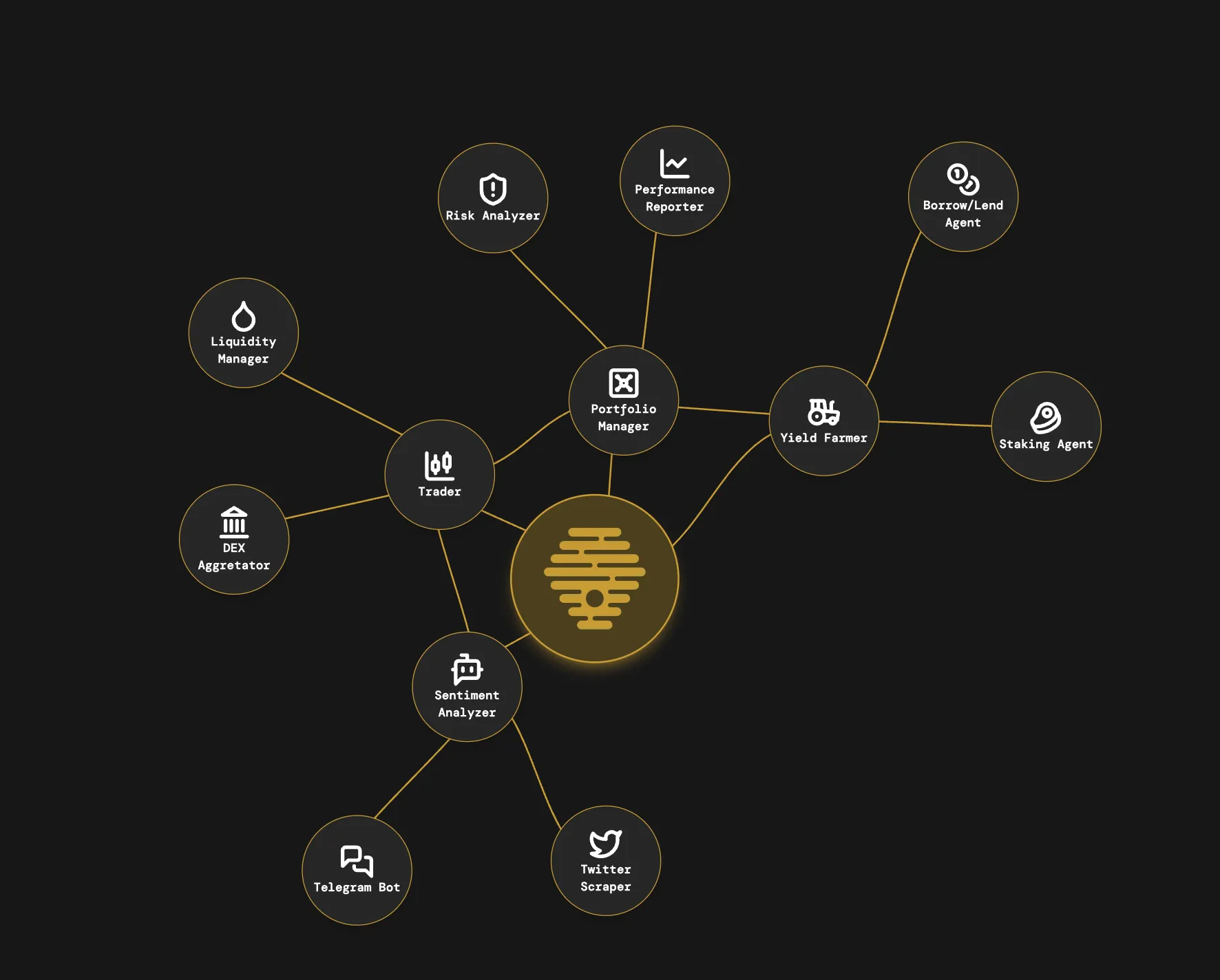
Currently, there are DeFAI applications on the market that can achieve intent-centric trading, such as Griffain, Hey Anon, Orbit, The Hive, and Neur, but many of them are in internal testing or beta stages (Griffain, Hey Anon), not free (Griffain, Neur), or not open-source (Hey Anon, Griffain, Orbit). The only completely free and open-source option is The Hive, which deserves recognition for its developers. The application page can be found athttps://www.askthehive.ai/chat.
The entire page centers around a chat box, with LLM supporting OpenAI, Anthropic, XAI, Gemini, and Deepseek. There are also four functional modules below: Trending, Stake, Trade, and Knowledge.
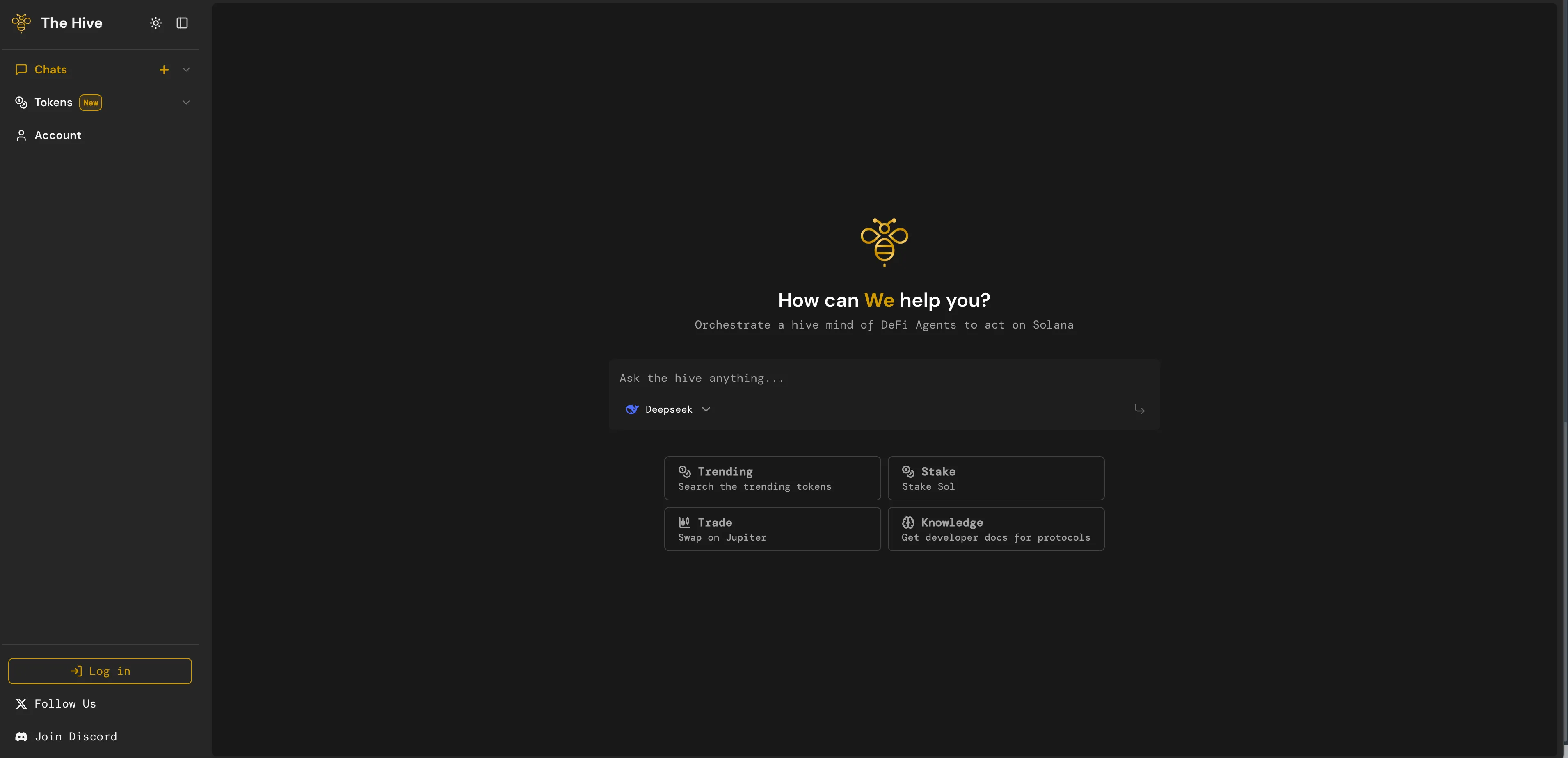
The primary way to use it is still through the chat box to express intents. For example, by entering "Swap 1000 $USDC to $BUZZ on Solana", The Hive will invoke the Trading Agent and pop up a plugin. By clicking "Connect", users can link their (Phantom) wallet, sign, and send the transaction.

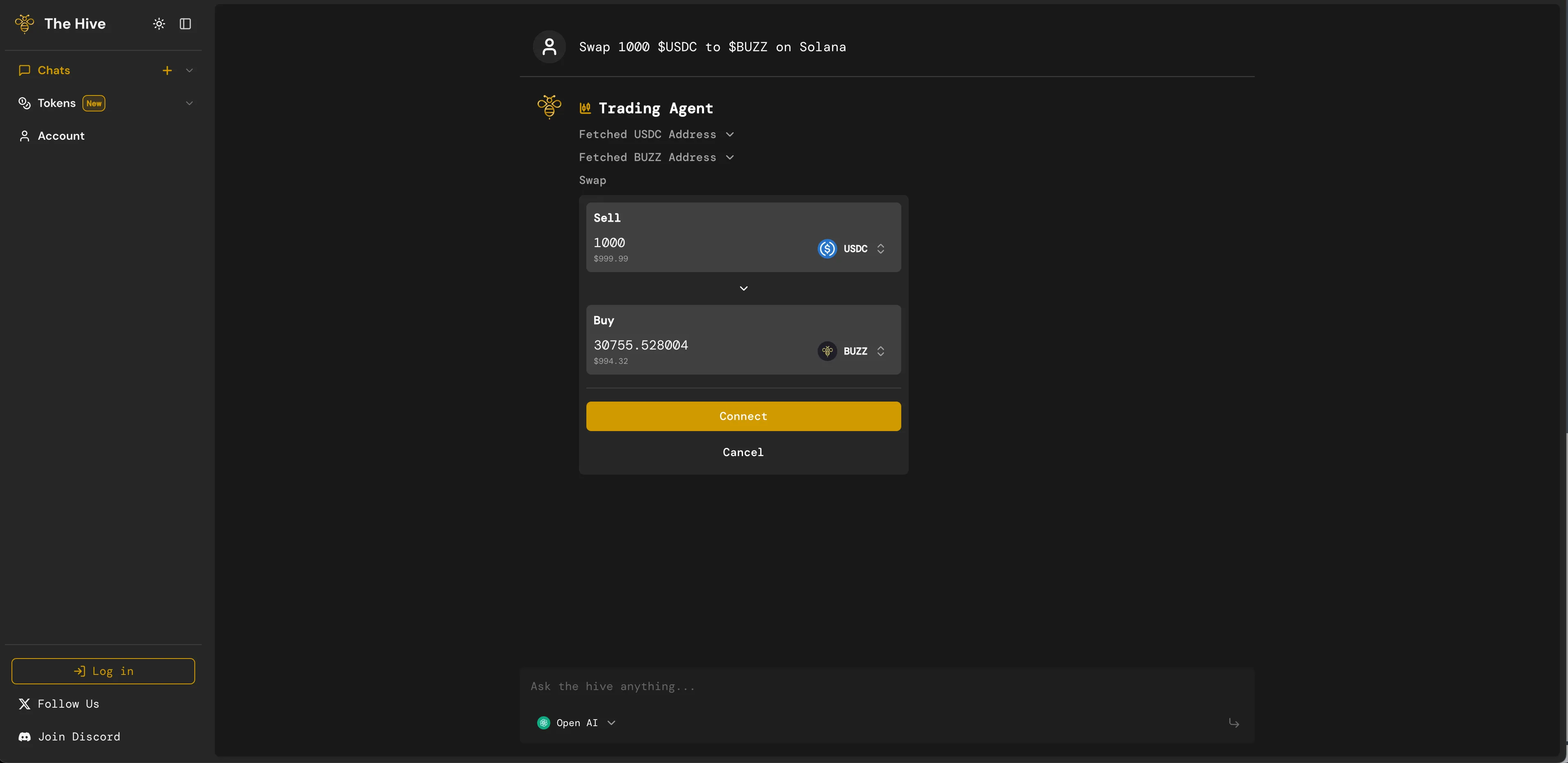
Users can also input "Analyze the trending of $ETH" to analyze the recent trend of Ethereum. The Hive will then call the Token Analysis Agent to display basic information about Ethereum, market conditions, price trends, transaction details, and active wallet activity, along with trading suggestions.
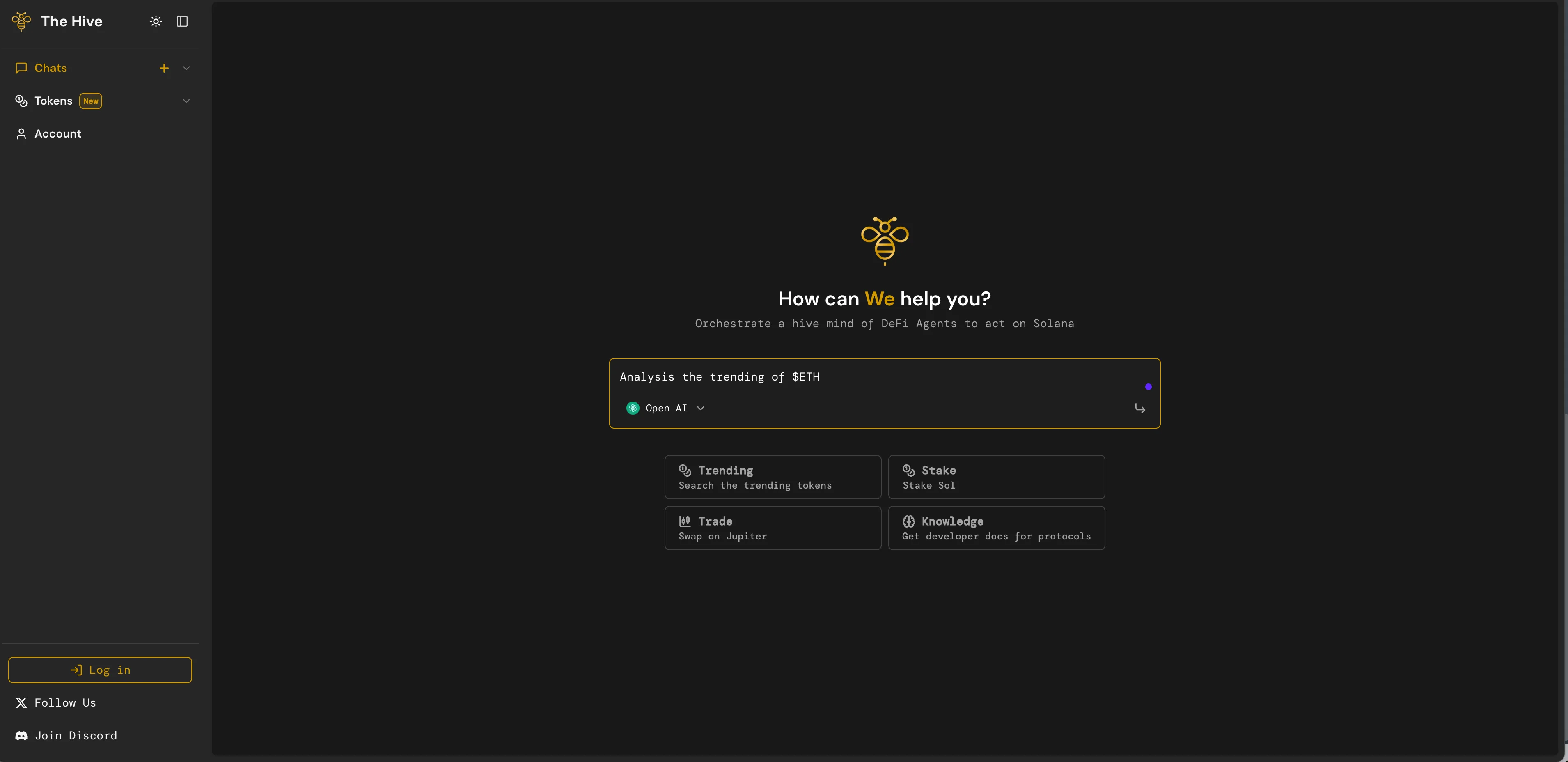
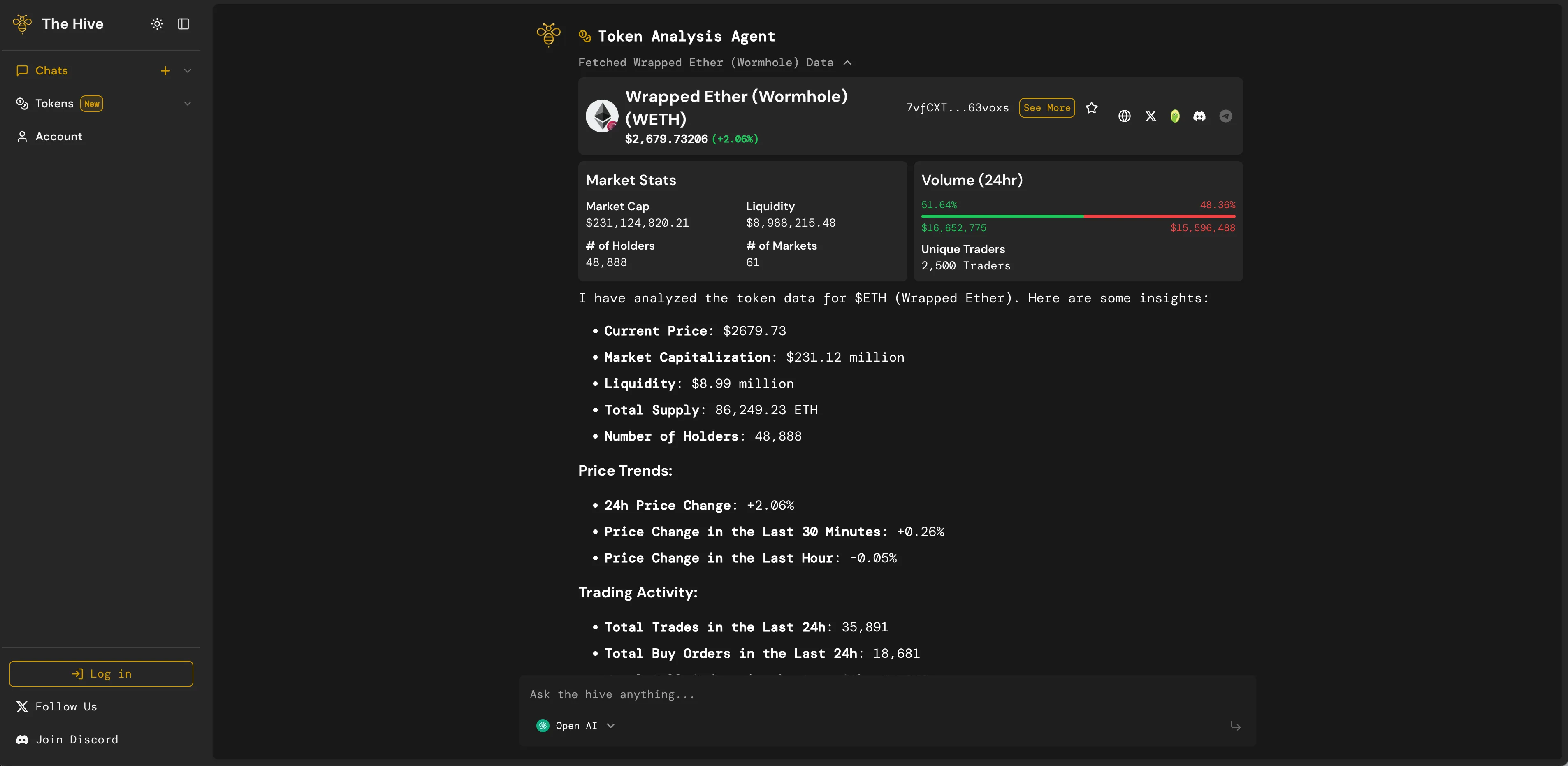
Additionally, users can ask, "What is DeFi?" and The Hive will invoke the Knowledge Agent to return DeFi-related knowledge to them.
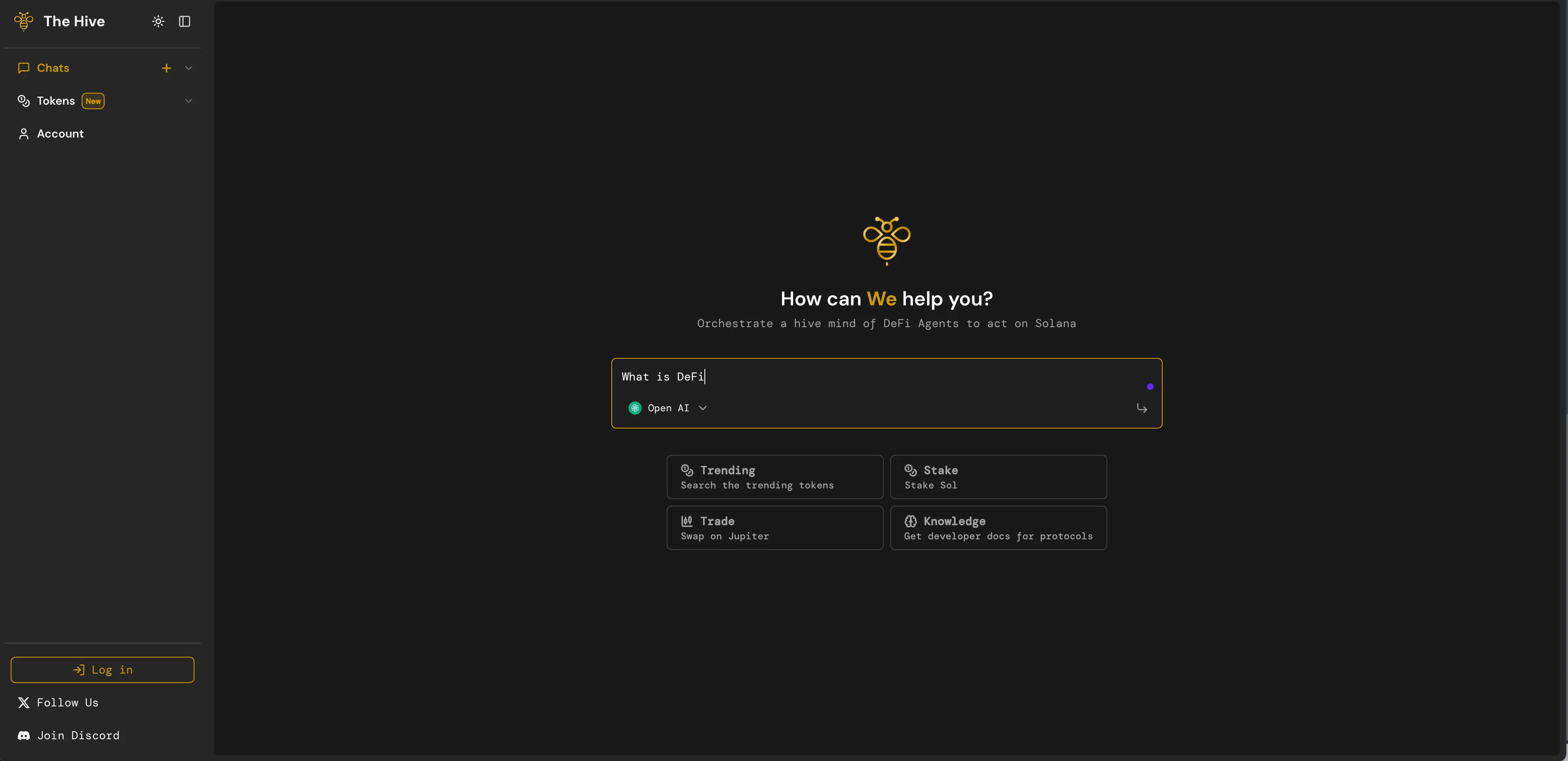
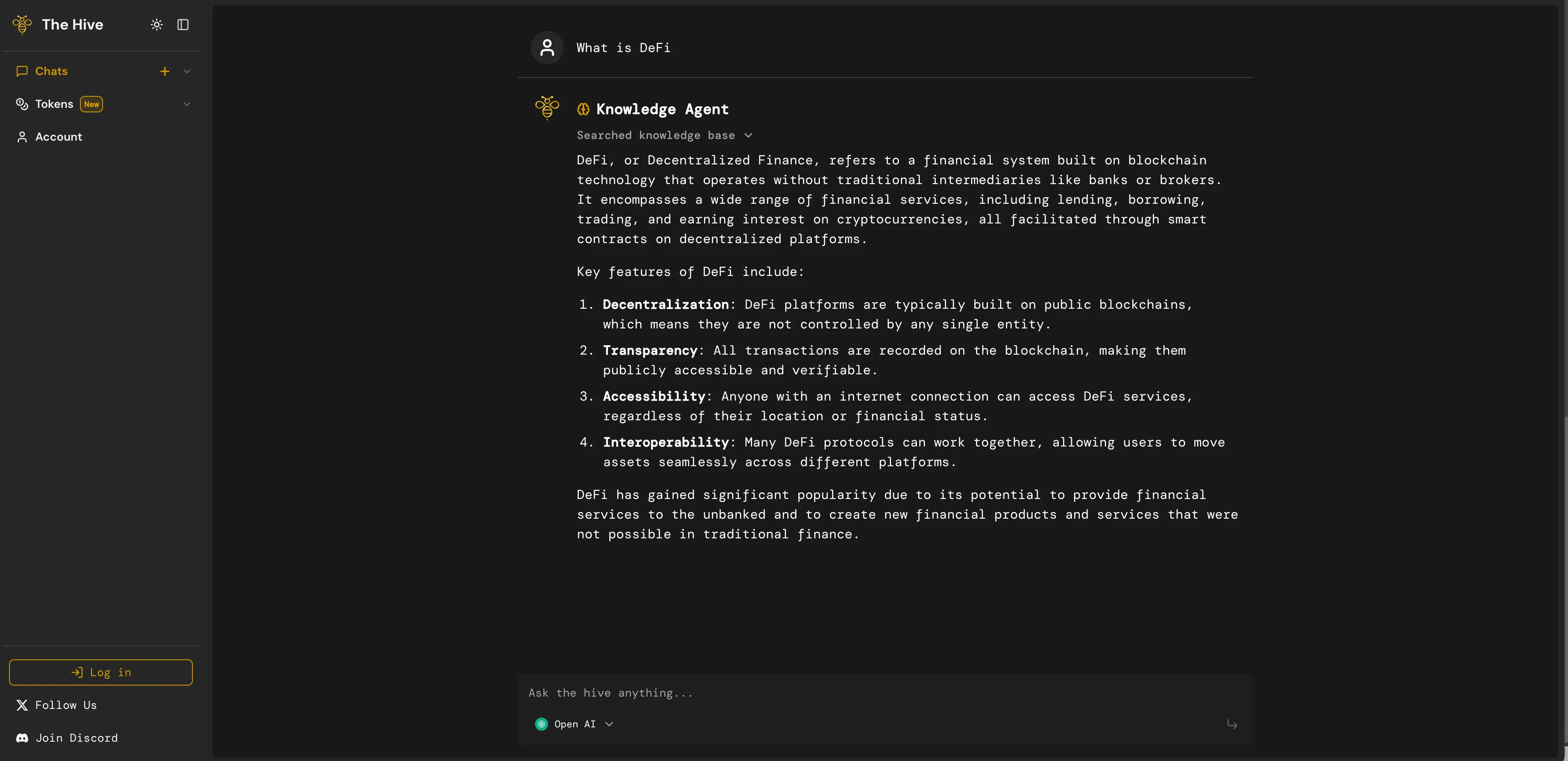
These are just a few simple examples; The Hive's functionality is far richer and continually evolving. For instance, the newly added Tokens page can showcase popular cryptocurrencies and the inflow of "smart money", which benefits users engaged in meme, pump.fun, and gmgn.
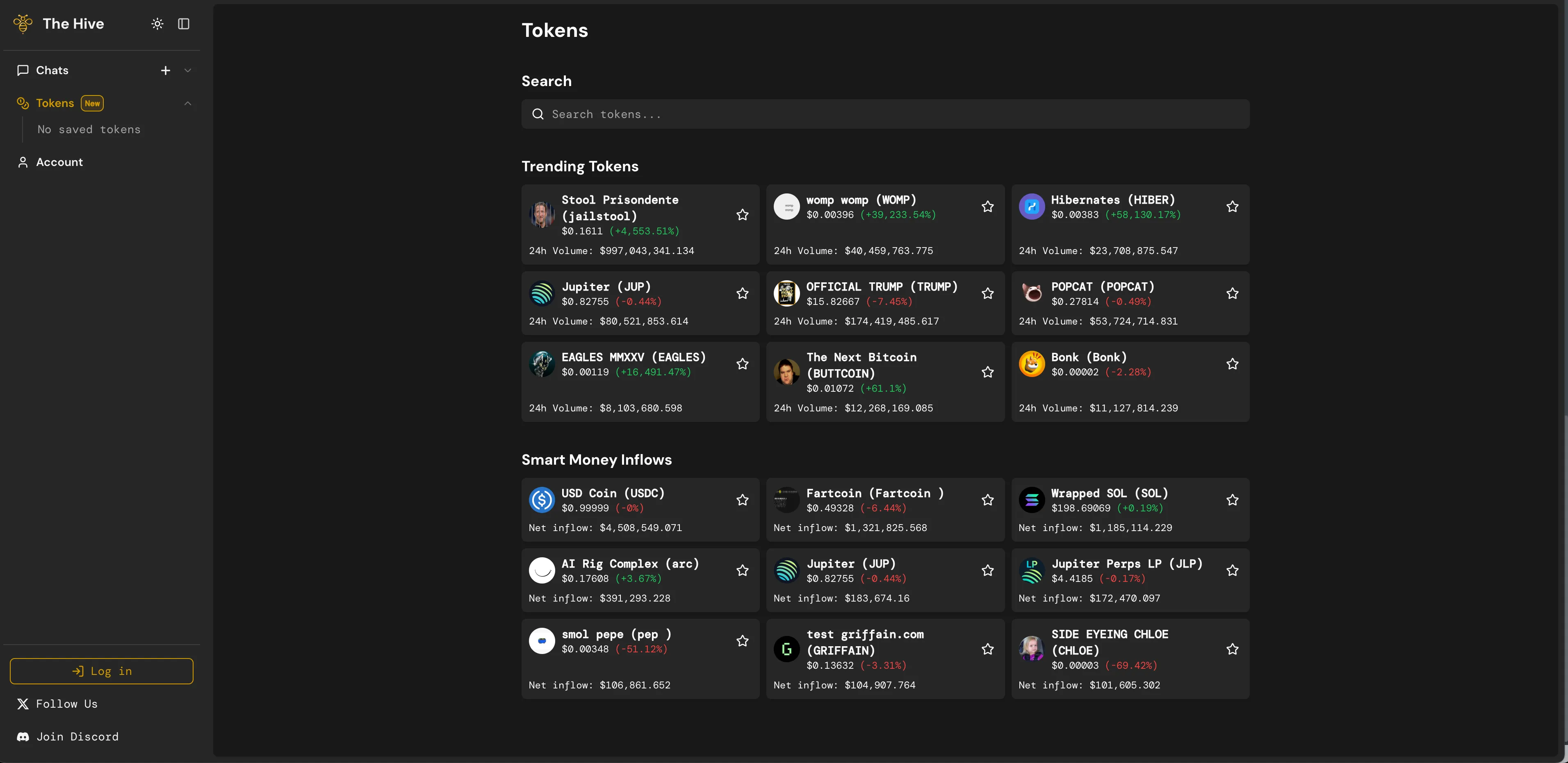
The Hive's code repository is available athttps://github.com/ask-the-hive/the-hive, where we can conduct a brief analysis of its implementation principles.
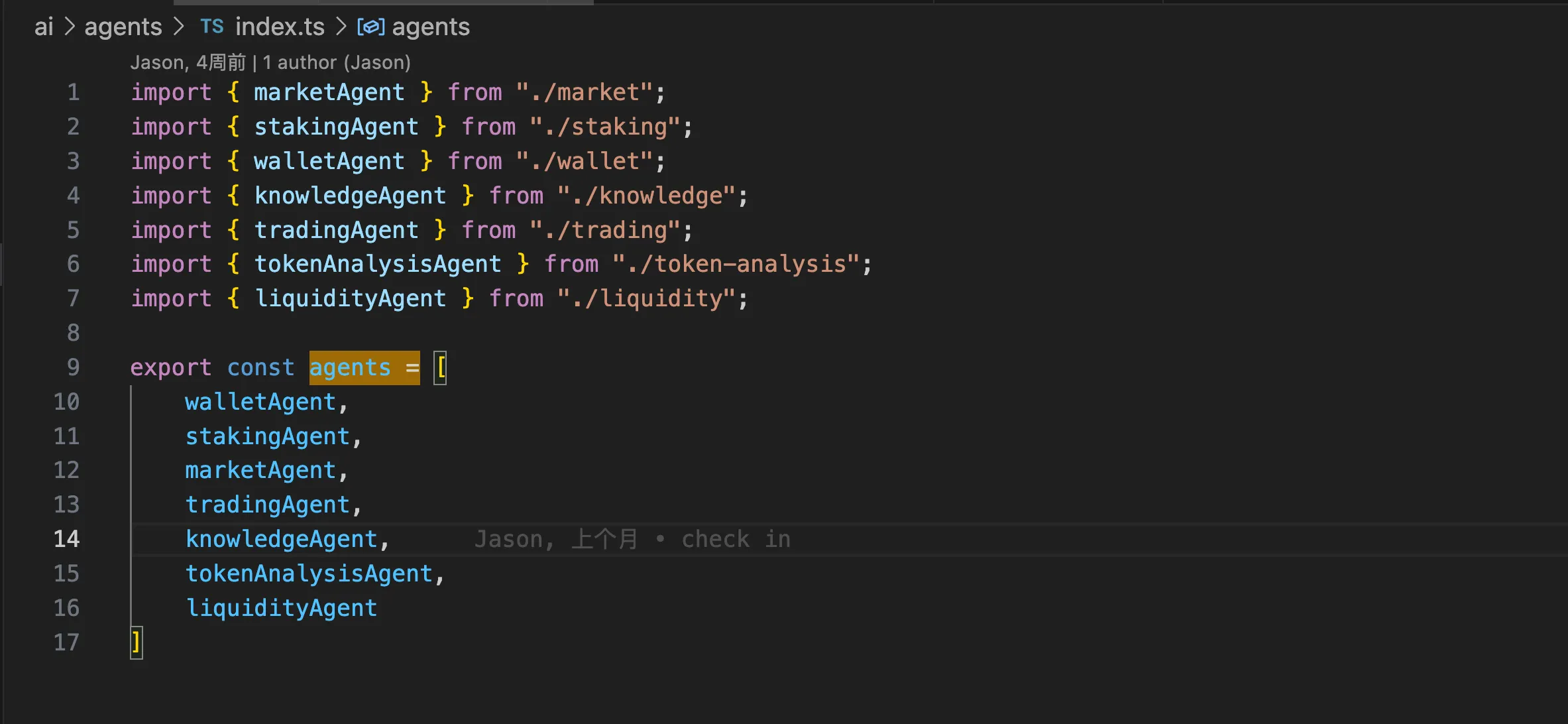
The Hive defines an external list of Agents, currently consisting of seven Agents:
1walletAgent - responsible for Solana wallet operations, encapsulating tools for querying token balances and transferring tokens;
2stakingAgent - responsible for Solana staking operations, encapsulating tools for delegate staking and liquid staking;
3marketAgent - responsible for market-related inquiries, encapsulating tools for monitoring cryptocurrency market conditions and whale activities;
4tradingAgent - responsible for DEX-related operations on Solana, encapsulating tools for querying token addresses and Jupiter aggregation;
5knowledgeAgent - responsible for knowledge base-related queries, primarily focusing on the DeFi ecosystem knowledge on Solana;
6tokenAnalysisAgent - responsible for the analysis of specific tokens; compared to the market agent, it is better suited for analyzing particular tokens and encapsulates tools for capturing Twitter information;
7liquidAgent - responsible for liquidity-related queries regarding token pairs, encapsulating tools like Raydium and Dexscreener.
The core logic involves analyzing user input through LLM to identify suitable Agents. The author has defined prompts and toolsets for each Agent, and the AI Agent framework organizes the workflow among the Agents, ultimately returning the execution results to the user. The AI Agent framework is also implemented by the author (having incorporated the Solana Agent Kit but not actually using it, or possibly removing it in earlier versions).
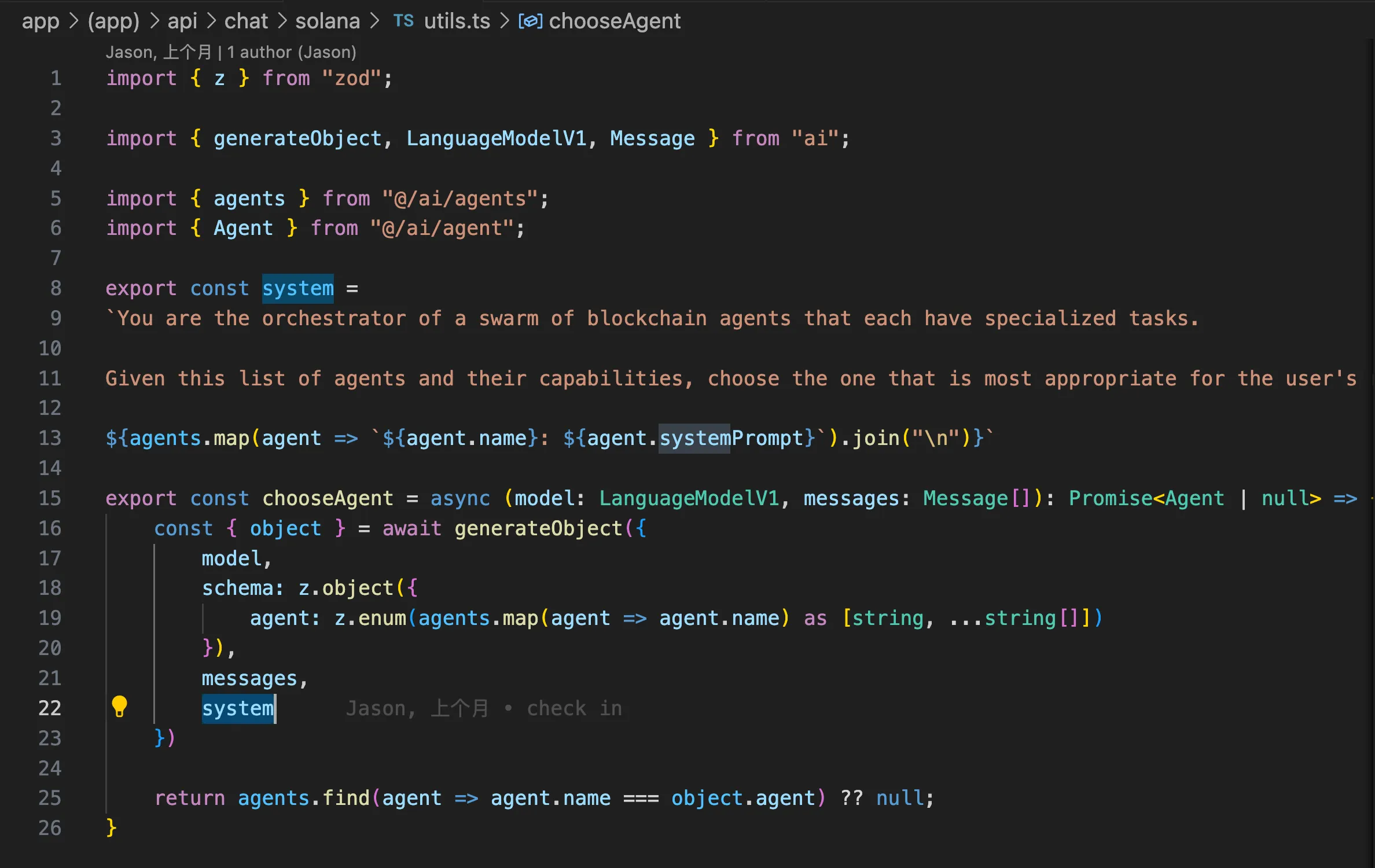
Conclusion
For a long time, Web3 has been criticized for offering a poor user experience, which has hindered the widespread adoption of innovative applications like DeFi.
The emergence of "intent-centric trading" has provided a solution by allowing users to define their desired on-chain outcomes and outsourcing the difficult technical work needed to achieve these results to third-party solvers that directly interact with the network and protocols on behalf of users, thereby shortening the complex curve to accessing DeFi.
The advent of DeFAI has further revolutionized this concept, transforming the curve into a straight line. By leveraging AI technology to provide a natural language interface, users can intuitively carry out DeFi transactions and management, simplifying the complexities of DeFi operations and enhancing the on-chain user experience, thus delivering real value to users.
A technology must create genuine value and offer tangible convenience to truly be accepted by the public. The emergence of DeFAI holds the potential to fundamentally change the interaction paradigm of Web3, allowing even users with little understanding of blockchain and DeFi to participate in the Web3 wave.
Tip: This article is for technical sharing purposes only and does not constitute any recommendations or advice
若有收获,就点个赞吧
About ZAN
As a technology brand of Ant Digital Technologies for Web3 products and services, ZAN provides rich and reliable services for business innovations and a development platform for Web3 endeavors.
The ZAN product family includes ZAN Node Service, ZAN PowerZebra (zk acceleration), ZAN Identity (Know your customers and clients), ZAN Smart Contract Review, with more products in the pipeline.